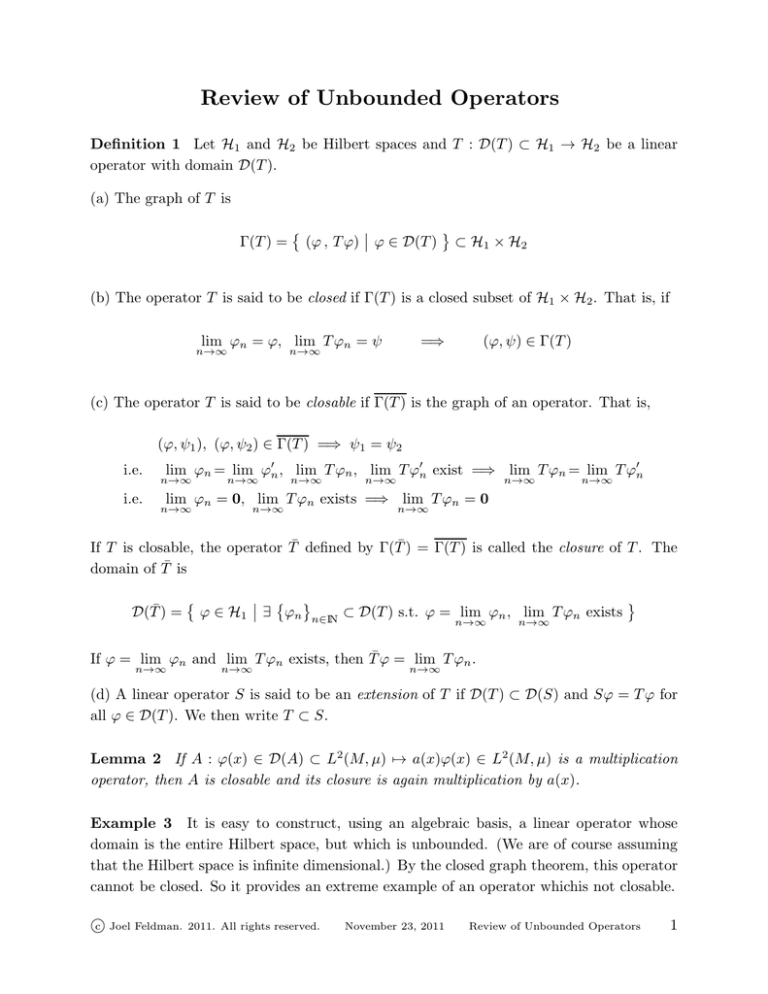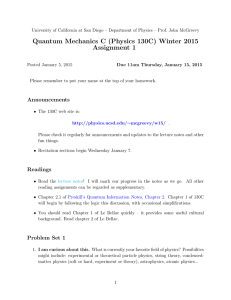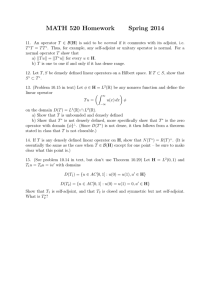Review of Unbounded Operators
advertisement

Review of Unbounded Operators
Definition 1 Let H1 and H2 be Hilbert spaces and T : D(T ) ⊂ H1 → H2 be a linear
operator with domain D(T ).
(a) The graph of T is
Γ(T ) =
(ϕ , T ϕ) ϕ ∈ D(T ) ⊂ H1 × H2
(b) The operator T is said to be closed if Γ(T ) is a closed subset of H1 × H2 . That is, if
lim ϕn = ϕ, lim T ϕn = ψ
n→∞
(ϕ, ψ) ∈ Γ(T )
=⇒
n→∞
(c) The operator T is said to be closable if Γ(T ) is the graph of an operator. That is,
(ϕ, ψ1 ), (ϕ, ψ2 ) ∈ Γ(T ) =⇒ ψ1 = ψ2
i.e.
i.e.
lim ϕn = lim ϕ′n , lim T ϕn , lim T ϕ′n exist =⇒ lim T ϕn = lim T ϕ′n
n→∞
n→∞
n→∞
n→∞
n→∞
n→∞
lim ϕn = 0, lim T ϕn exists =⇒ lim T ϕn = 0
n→∞
n→∞
n→∞
If T is closable, the operator T̄ defined by Γ(T̄ ) = Γ(T ) is called the closure of T . The
domain of T̄ is
D(T̄ ) =
ϕ ∈ H1 ∃ ϕn n∈IN ⊂ D(T ) s.t. ϕ = lim ϕn , lim T ϕn exists
n→∞
n→∞
If ϕ = lim ϕn and lim T ϕn exists, then T̄ ϕ = lim T ϕn .
n→∞
n→∞
n→∞
(d) A linear operator S is said to be an extension of T if D(T ) ⊂ D(S) and Sϕ = T ϕ for
all ϕ ∈ D(T ). We then write T ⊂ S.
Lemma 2 If A : ϕ(x) ∈ D(A) ⊂ L2 (M, µ) →
7 a(x)ϕ(x) ∈ L2 (M, µ) is a multiplication
operator, then A is closable and its closure is again multiplication by a(x).
Example 3 It is easy to construct, using an algebraic basis, a linear operator whose
domain is the entire Hilbert space, but which is unbounded. (We are of course assuming
that the Hilbert space is infinite dimensional.) By the closed graph theorem, this operator
cannot be closed. So it provides an extreme example of an operator whichis not closable.
c Joel Feldman.
2011. All rights reserved.
November 23, 2011
Review of Unbounded Operators
1
Example 4 On the other hand, it is also possible for an operator to have many closed
extensions. Here is an example. The Hilbert space is H = L2 (IR) and the operator is
D(A) =
R∞
R∞
f ∈ C0∞ (IR) −∞ f (k) dk = −∞ kf (k) dk = 0
(Af )(k) = (1 + k 2 )f (k)
2
If you take Fourier tranforms, this operator becomes the differential operator − ddx2 + 1
ˆ
with “initial conditions” fˆ(0) = df (0) = 0. Set
dx
p0 (k) =
1
1+k2
p1 (k) =
k
1+k2
The the closure of A is
D(Ā) =
f ∈ L2 (IR) (1 + k 2 )f ∈ L2 (IR), (1 + k 2 )f ⊥ p0 , p1
(Āf )(k) = (1 + k 2 )f (k)
Choose any nonzero p, q ∈ span{p0 , p1 } and a nonzero p⊥ ∈ span{p0 , p1 } which is perpendicular to p. The following are all closed extensions of A.
(A1 f )(k) = (1 + k 2 )f (k)
f ∈ L2 (IR) (1 + k 2 )f ∈ L2 (IR), (1 + k 2 )f ⊥ p
D(A2 ) = f ∈ L2 (IR) (1 + k 2 )f ∈ L2 (IR)
(A2 f )(k) = (1 + k 2 )f (k)
p⊥
α ∈ C, (1 + k 2 )f ∈ {p0 , p1 }⊥
D(A3 ) = D(A1 ) = α 1+k
2 + f
p⊥
A3 α 1+k
= αq + (1 + k 2 )f
2 + f
D(A1 ) =
Definition 5 Let T be a densely defined linear operator on a Hilbert space H. The
adjoint T ∗ of T is defined by
ϕ ∈ D(T ∗ ) ⇐⇒ ∃ η ∈ H s.t. hT ψ, ϕiH = hψ, ηiH ∀ ψ ∈ D(T )
T ∗ ϕ = η ⇐⇒ hT ψ, ϕiH = hψ, ηiH ∀ ψ ∈ D(T )
Remark 6
(a) The η of the last definition is unique when it exists, because D(T ) is dense.
(b) By the Riesz representation theorem, ϕ ∈ D(T ∗ ) if and only if there is a constant Kϕ
such that hT ψ, ϕiH ≤ Kϕ kψkH for all ψ ∈ D(T ).
(c) 0 ∈ D(T ∗ ) always.
(d) If S ⊂ T , then T ∗ ⊂ S ∗ .
c Joel Feldman.
2011. All rights reserved.
November 23, 2011
Review of Unbounded Operators
2
Example 7 The following example shows that it is possible to have D(T ∗ ) = {0}. Let
◦ H = L2 (IR),
◦ en n∈IN be an orthonormal basis for H and
◦ for each k ∈ IN, fk (x) = eikx . Note that fk ∈
/ H.
We define the domain of T to be D(T ) = B0 (IR), the set of all bounded Borel functions on
IR that are of compact support. This domain is dense in L2 (IR). For ϕ ∈ D(T ),
Tϕ =
∞ Z
X
∞
fn (x)ϕ(x) dx en
−∞
n=1
Step 1: We first check that T is well–defined. Let ϕ ∈ D(T ). Then there is some integer
m such that ϕ(x) vanishes outside of [−mπ, mπ]. Then, for each k ∈ ZZ,
Z ∞
Z mπ
Z π
fk (x)ϕ(x) dx =
fk (x)ϕ(x) dx =
eikmt mϕ(mt) dt
−mπ
−∞
−π
is the kmth Fourier coefficient of the function mϕ(mt). Since the sum of the squares of all
of the Fourier coefficents is, up to a factor of 2π, the L2 norm of mϕ(mt), which is finite,
T is well–defined.
Step 2: We now check that D(T ∗ ) = {0}. Let ψ ∈ D(T ∗ ) and ϕ ∈ D(T ) = B0 (IR). Pick
an m ∈ IN with ϕ(x) vanishing except for x in [−mπ, mπ]. Then
∗
hϕ, T ψi = hT ϕ, ψi =
∞ Z
X
n=1
Since
The series
Z
P∞
∞
fn (x)ϕ(x) dx
−∞
mπ
fk (x)fℓ (x) dx =
−mπ
n=1
Z
hen , ψi =
e
dx =
−mπ
ϕ , hen , ψi fn
n=1
mπ
i(ℓ−k)x
∞ D
X
2mπ
0
E
if k = ℓ
if k =
6 ℓ
hen , ψi fn converges in H and
D
E
∞
P
hϕ, T ∗ ψi = ϕ ,
hen , ψi fn
n=1
This is true for all bounded Borel functions ϕ supported in [−mπ, mπ] so that
T ∗ψ =
∞
P
hen , ψi fn
a.e. on [−mπ, mπ]
n=1
and
∞ > T ∗ ψ L2 (IR)
∞
X
∗ hen , ψi 2 (2mπ)
≥ T ψ L2 ([−mπ,mπ]) =
n=1
Since this is true for all m, we must have hen , ψi = 0 for all n ∈ IN and hence ψ = 0.
c Joel Feldman.
2011. All rights reserved.
November 23, 2011
Review of Unbounded Operators
3
Theorem 8 Let H be a Hilbert space and let T : D(T ) ⊂ H → H be a densely defined
linear operator. Then
(a) T ∗ is closed.
(b) T is closable if and only if D(T ∗ ) is dense. If so, T̄ = T ∗∗ .
(c) If T is closable, then (T̄ )∗ = T ∗ .
Definition 9 Let H be a Hilbert space and let T : D(T ) ⊂ H → H be a densely defined
linear operator.
(a) T is called symmetric if
hϕ, T ψi = hT ψ, ϕi
for all ϕ, ψ ∈ D(T )
That is, if T ⊂ T ∗ .
(b) T is called self–adjoint if T = T ∗ .
Remark 10
(a) If T is self–adjoint, then it is automatically closed.
(b) Let (M, µ) be a measure space. If f (m) is a real–valued, measurable function on M ,
then the operator of multiplication by f , with domain ψ ∈ L2 (M, µ) f ψ ∈ L2 (M, µ)
is self–adjoint.
Theorem 11 Let H be a Hilbert space. A densely defined, symmetric operator T : D(T ) ⊂
H → H is self–adjoint if and only if the ranges of ran(T − i1l) = ran(T + i1l) = H.
Definition 12 Let T be a densely defined, closed operator on a Hilbert space H.
(a) The resolvent set, ρ(T ), of T is the set of all complex numbers λ such that λ1l − T is a
bijection (between D(T ) and H) with bounded inverse.
−1
(b) The resolvent of T at λ ∈ ρ(T ) ⊂ C is Rλ (T ) = λ1l − T
.
(c) The spectrum of T is σ(T ) = C \ ρ(T ).
(d) The complex number λ is in the point spectrum, σp (T ), of T if λ1l − T is not injective.
That is, if there is a nonzero vector x ∈ H such that T x = λx. Then x is said to be an
eigenvector of T with eigenvalue λ.
(e) The complex number λ is in the residual spectrum, σr (T ), of T if λ1l − T is injective
but the range of T is not dense in B.
c Joel Feldman.
2011. All rights reserved.
November 23, 2011
Review of Unbounded Operators
4
Example 13 Here is an example which shows, firstly, that an ubounded operator T may
have σ(T ) = ∅ and secondly that “just changing the domain of an operator” can change
its spectrum. The Hlbert space H = L2 ([0, 1]). Denote by AC[0, 1] the set of all functions
Rx
f : [0, 1] → C of the form f (x) = C + 0 ϕ(t) dt with C ∈ C and ϕ ∈ L2 ([0, 1]). For such a
df
function, define dx
(x) = ϕ(x). All of the operators in this example will be closed operators
df
(x).
with domain contained in AC[0, 1] and all operators will have the action f (x) 7→ i dx
Here are the examples.
df
, then σ(T ) = C. In fact σp (T ) = C, since, for any
(a) If D(T ) = AC[0, 1] with T f = i dx
−iλx
is an eigenfunction for T with eigenvalue λ.
λ ∈ C, e
df
, then σ(T ) = ∅. In fact, for any
(b) If D(T ) = f ∈ AC[0, 1] f (0) = 0 with T f = i dx
−1
λ ∈ C, the resolvent operator (λ1l − T ) is
Z x
Rλ (T )ψ (x) = i
e−iλ(x−t) ψ(t) dt
0
df
(c) Let α ∈ C be nonzero. If D(T ) = f ∈ AC[0, 1] f (0) = αf (1) with T f = i dx
,
then σ(T ) =
− i ln α + 2kπ k ∈ ZZ . Again the spectrum consists solely of
eigenvalues. If λ = −i ln α + 2kπ for some k ∈ ZZ, then e−iλx is an eigenfunction for
T with eigenvalue λ. For λ not of the form −i ln α + 2kπ for all k ∈ ZZ, the resolvent
operator (λ1l − T )−1 is
Z 1
Gλ (x, t)ψ(t) dt
Rλ (T )ψ (x) =
0
with
Gλ (x, t) =
iλ(t−x−1)
iαe −iλ
1−αe
iλ(t−x)
ie
1−αe−iλ
if x < t
if x > t
Theorem 14 (Cayley Transform) Let H be a Hilbert space.
(a) If A = A∗ is a self–adjoint operator on H, then C+ (A) = (A − i1l)(A + i1l)−1 exists
and is a unitary operator on H. Furthermore 1 ∈
/ σp C+ (A) .
(b) If U is a unitary operator on H and 1 ∈
/ σp (U ), then C− (U ) = i(1l + U )(1l − U )−1 exists
and is self–adjoint.
(c) C+ and C− are inverses. That is, C+ C− (U ) = U and C− C+ (A) = A for all
unitary U with 1 ∈
/ σp (U ) and all self–adjoint A.
(d) If T is a symmetric operator with domain D(T ), then C+ (T ) = (T − i1l)(T + i1l)−1 is a
well–defined isometric operator with domain R(T + i1l) and range R(T − i1l). Furthermore
1∈
/ σp C+ (T ) and T = C− C+ (T ) .
c Joel Feldman.
2011. All rights reserved.
November 23, 2011
Review of Unbounded Operators
5
Remark 15 Let T be a symmetric operator. By the last theorem, there is a one–to–one
correspondance between self–adjoint extensions of T and unitary operators U that
(a) extend the isometric operator C+ (T ) and
(b) obey 1 ∈
/ σp (U ).
First forget about the condition that 1 ∈
/ σp (U ). It’s a simple matter to construct all unitary operators that extend C+ (T ). Since the closure C+ (T ) is an isometric operator with
domain R(T + i1l) and range R(T − i1l), there is a one–to–one–correspondance between
such unitary extensions and unitary maps Ũ : R(T + i1l)⊥ → R(T − i1l)⊥ . Now back to
condition (b). The following lemma shows it is automatically satisfied!
Lemma 16 Let H be a Hilbert space and T : D(T ) ⊂ H → H be a densely defined,
symmetric operator. Let U be a unitary extension of C+ (T ). Then 1 ∈
/ σp (U ).
Definition 17 An operator is called essentially self–adjoint if its closure is self–adjoint.
A subset D ⊂ H is called a core for the self–adjoint operator T if T ↾ D = T .
Theorem 18 Let T be a densely defined operator on a Hilbert space H. Then
T is essentially self–adjoint ⇐⇒ T has a unique self–adjoint extension
Theorem 19 Let T be a symmetric operator on a Hilbert space H.
(a) If dim (T + i)⊥ = dim (T − i)⊥ = 0, then T has a unique self–adjoint extension, and
so is essentially self–adjoint.
(b) If dim (T + i)⊥ = dim (T − i)⊥ ≥ 1, then T has infinitely many distinct self–adjoint
extensions.
(c) If dim (T + i)⊥ 6= dim (T − i)⊥ , then T has no self–adjoint extensions.
Theorem 20 (Spectral Theorem - Multiplication Operator Version)
Let A be a self–adjoint operator on a Hilbert space H. There exist
◦ a measure space hM, µi,
◦ a measurable function a : M → IR, and
◦ a unitary operator U : H → L2 (M, µ)
such that U AU −1 is the operator of multiplication by the function a(m), with domain
ϕ ∈ L2 (M, µ) aϕ ∈ L2 (M, µ) . If H is separable, µ can be chosen to be a finite
measure.
c Joel Feldman.
2011. All rights reserved.
November 23, 2011
Review of Unbounded Operators
6
Definition 21 (Projection Valued Measure)
(a) Denote by BIR the σ–algebra of Borel subsets of IR and by L(H) the set of a bounded
operators on H. A projection valued measure is a map E : BIR → L(H) that obeys the
following conditions.
(i) For each B ∈ BIR , the operator E(B) is an orthogonal projection on some closed
subspace of H. That is, E(B)2 = E(B) and E(B) = E(B)∗ .
(ii) E(∅) = 0 and E(IR) = 1l
(iii) If Bn n∈IN is a countable family of disjoint Borel subsets of IR, then
E
S
∞
Bn
n=1
= s-lim
N→∞
N
X
E(Bn)
n=1
(iv) E(B1 ∩ B2 ) = E(B1 )E(B2 ) for all B1 , B2 ∈ BIR . (This condition is a consequence
of (i) and (iii).)
(b) Given a projection valued measure E and a Borel function g (not necessarily bounded),
R
the operator g(λ) dE(λ) is defined by
Z
o
n
D
g(λ) dE(λ = ψ ∈ H |g(λ)|2 d hψ, E(λ)ψi < ∞
Z
Z
ψ, g(λ) dE(λ) ϕ = g(λ) d hψ, E(λ)ϕi
Z
Theorem 22 (Spectral Theorem - Projection–valued Measure Version)
There is a 1–1 correspondence between self–adjoint operators and projection–valued measures A ↔ EA such that
Z
A = λ dEA (λ)
c Joel Feldman.
2011. All rights reserved.
November 23, 2011
Review of Unbounded Operators
7






